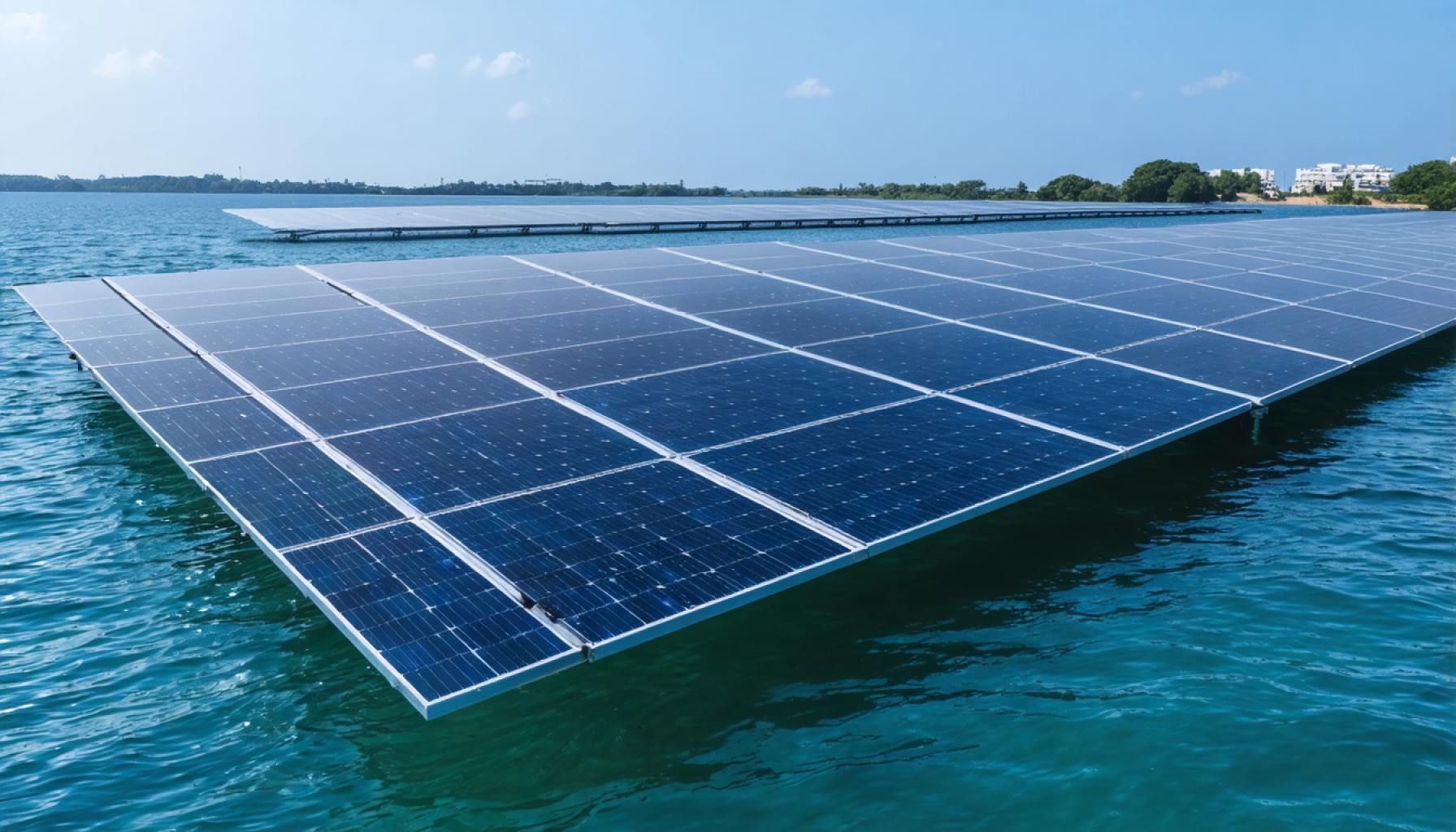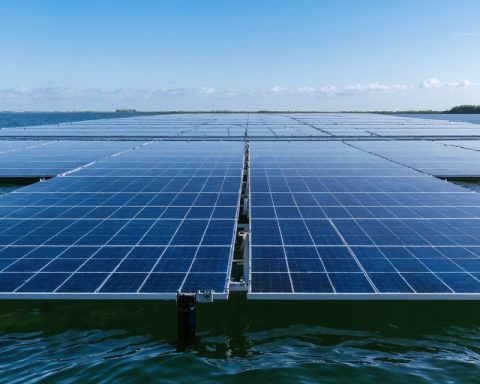- Floating solar farms utilize water surfaces to harness solar energy efficiently while conserving land space.
- This technology enhances solar panel efficiency by maintaining cooler operating conditions over water.
- Asia, led by China and India, and Europe, including the UK, are at the forefront of floating solar installations.
- Global capacity for floating solar energy could surpass 400 gigawatts, supporting carbon reduction and sustainable energy goals.
- Advancements in photovoltaic technology and engineering are critical to the success of these projects.
- While challenges exist, ongoing research addresses ecological impacts and cost issues to ensure environmental harmony.
- Floating solar farms demonstrate the synergy of innovation and sustainability, promoting a cleaner, greener future.
Visualize this: Vast shimmering mirrors drifting on serene water bodies, harnessing the sun’s abundant energy. These aren’t science fiction wonders but real-life innovations known as floating solar farms. Burgeoning from Asia’s expansive lakes to Europe’s dynamic estuaries, these solar flotillas herald a new chapter in clean energy technology.
Floating solar farms ingeniously maximize limited land space by utilizing expansive water surfaces. This inventive approach not only transforms water bodies into powerhouses but also mitigates water evaporation, offering a dual benefit. By floating above water, solar panels operate under cooler conditions, enhancing efficiency and power output.
The Global Surge: Asia leads the charge with China and India deploying massive installations, capitalizing on their extensive water bodies. Europe isn’t far behind. The United Kingdom recently unveiled one of the world’s largest floating solar arrays, a gleaming testament to innovation and commitment to renewable energy.
Experts at the International Renewable Energy Agency note that the global capacity for floating solar farms could reach over 400 gigawatts. This surge aligns seamlessly with nations’ goals to reduce carbon footprints while embracing sustainable energy sources. By adapting vast reservoirs and dams, we witness an environmentally friendly metamorphosis of the world’s electrical grids.
The Expertise: Support from top scientists and engineers in photovoltaic technology ensures that these floating wonderlands deliver high-efficiency energy conversion. Collaborations across industries have accelerated advancements in buoyant materials and anchoring systems, transforming once-unthinkable concepts into success stories.
While challenges such as higher initial costs and ecological impacts on aquatic life exist, ongoing research promises innovative solutions. Environmental assessments are integral, ensuring the harmony between green energy and ecosystem sustainability.
Your Takeaway: Floating solar farms exemplify clean energy’s remarkable adaptability and potential. This technological marvel not only advances our renewable energy capabilities but also nurtures the very environment it seeks to protect. As these solar seas expand, the vision of a sustainable future gleams ever brighter on the horizon.
Floating solar farms carve a powerful narrative—where innovation meets sustainability, sparking a journey toward an energy-efficient world. Dive into this luminous transformation, and witness the sunlit path to our cleaner, greener future unfold.
Floating Solar Farms: The Future of Energy on Water
Understanding Floating Solar Farms: Benefits and Innovations
Floating solar farms represent a pioneering stride in renewable energy, skillfully leveraging unused water spaces to generate power sustainably. These innovative structures consist of solar panels mounted on platforms that float on water bodies such as lakes, reservoirs, and ponds. The primary advantages include conservation of land, reduction in water evaporation, and enhanced energy efficiency due to cooler operating conditions over water.
Key Benefits and Technological Advancements
1. Land Conservation: By using water surfaces, floating solar farms alleviate the need for vast land areas, which can be a limiting factor for traditional solar farms, especially in densely populated regions.
2. Reduced Water Evaporation: Floating the panels on water bodies significantly reduces evaporation, conserving water—a critical benefit in arid regions.
3. Improved Efficiency: Water naturally keeps the panels cooler, which can enhance their efficiency and extend their lifespan.
4. Advanced Materials and Design: The use of high-grade buoyant materials and sophisticated anchoring systems ensures stability and durability in various aquatic environments.
Global Adoption and Growth
– Asia’s Leadership: Asia, particularly China and India, dominates the floating solar market through ambitious projects, leveraging large lakes and reservoirs to meet energy demands sustainably.
– European Expansion: In Europe, countries like the UK and France are rapidly scaling up floating solar installations as part of their broader commitment to renewable energy and carbon neutrality.
– Future Projections: According to the International Renewable Energy Agency, global capacity for these farms could exceed 400 gigawatts in the coming decades.
Challenges and Solutions
– Costs: Initial setup costs are higher than traditional solar panels due to specialized materials and designs. However, costs are decreasing with technological advancements and economies of scale.
– Environmental Impact: Potential ecological disturbances to marine and bird life necessitate comprehensive environmental assessments. Ongoing research focuses on minimizing these impacts while maintaining ecosystem harmony.
Real-World Applications and Success Stories
– Agricultural Synergy: Countries like India integrate floating solar farms with agriculture, using water bodies near farms to power operations, thus embedding renewable energy in rural economies.
– Hybrid Solutions: Hybrid plants, combining hydroelectric and floating solar, are emerging, maximizing the energy yield from water resources.
Actionable Recommendations for Adoption
– Strategic Planning: Prioritize water bodies with minimal ecological disruption potential for floating solar projects.
– Collaboration with Environmental Scientists: Engage ecologists in planning stages to ensure sustainable coexistence with local flora and fauna.
– Government Incentives: Leverage subsidies, tax benefits, and grants offered by governments to offset initial costs and encourage adoption.
Conclusion and Future Outlook
Floating solar farms stand at the forefront of the renewable energy transition, offering an innovative solution to energy challenges by blending technology with environmental stewardship. As advancements continue and adoption rates rise, these floating solar solutions present a compelling narrative of sustainable progress and energy independence.
For further exploration into renewable energy technologies and innovations, visit International Renewable Energy Agency.
Quick Tips
– Explore pilot programs in local regions to understand feasibility and benefits.
– Engage in public-private partnerships for funding and technological support.
– Embrace community engagement to raise awareness and support for local projects.













